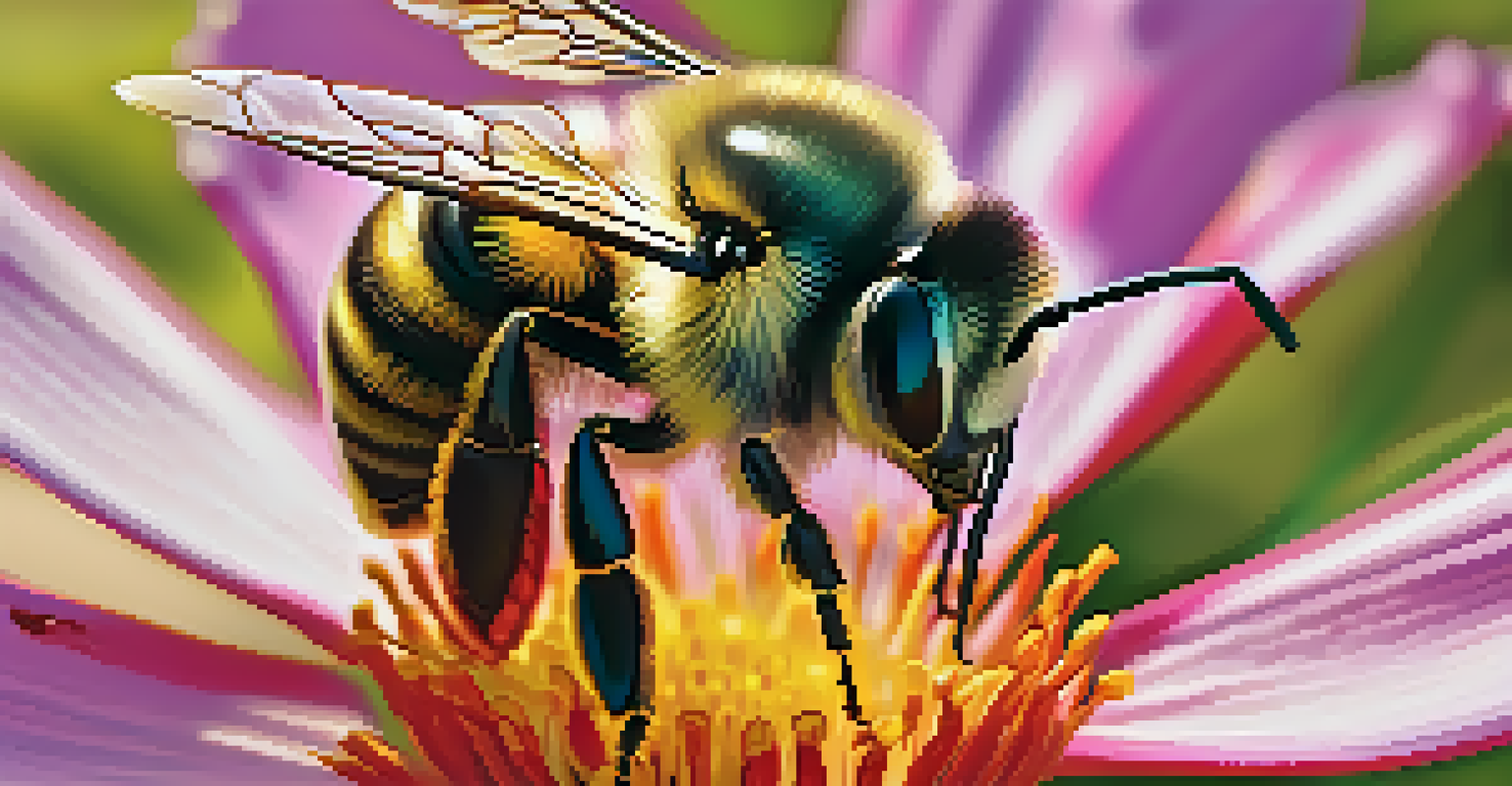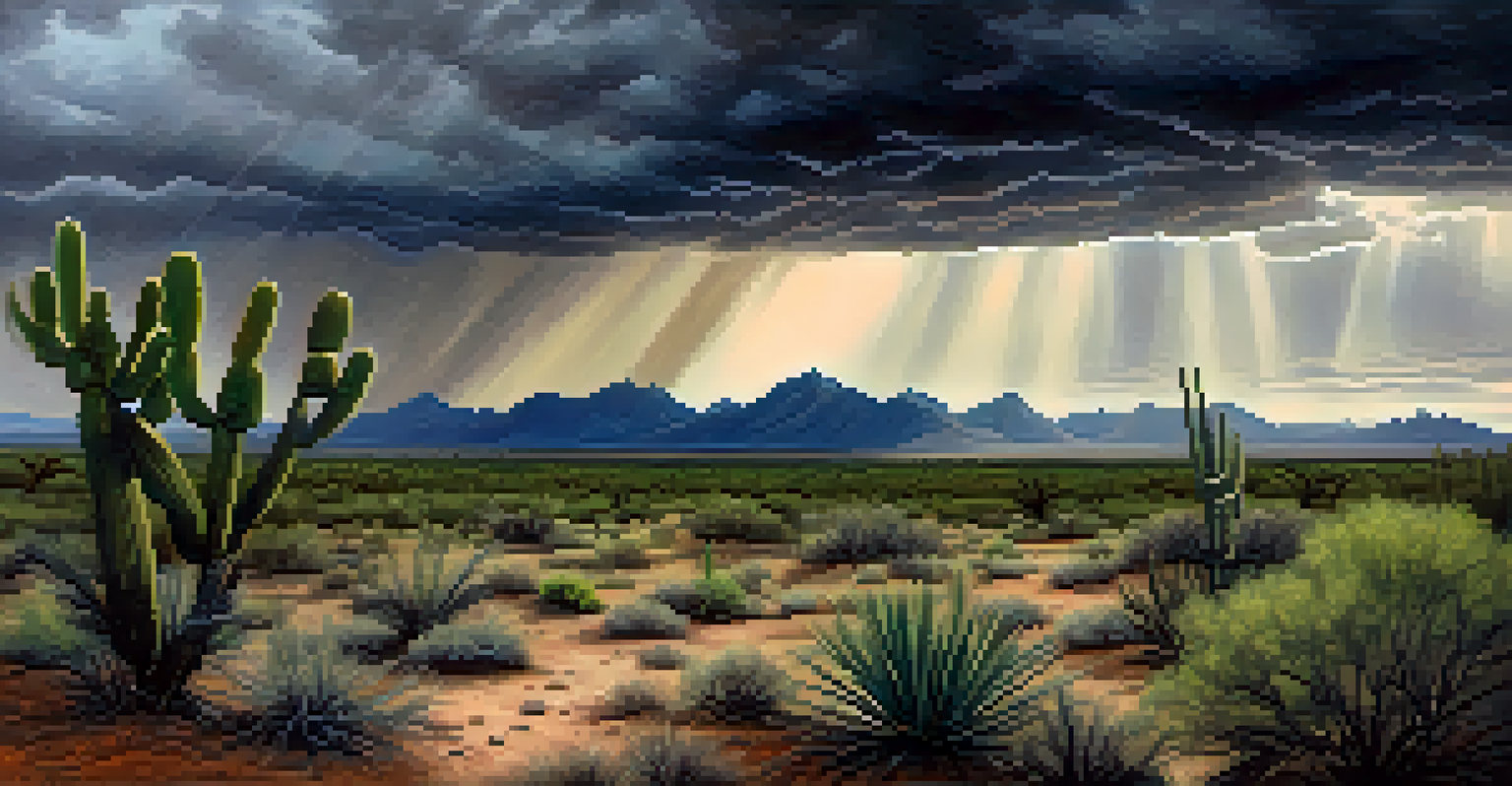How Climate Change Affects Tucson's Wildlife and Plants

Overview of Climate Change and Its Local Impact
Climate change refers to long-term shifts in temperature and weather patterns, primarily due to human activities. In Tucson, these shifts are becoming increasingly evident, impacting both the natural landscape and the creatures that inhabit it. Understanding how these changes affect local ecosystems is crucial for preserving Tucson's biodiversity.
The environment is where we all meet; where we all have a mutual interest; it is the one thing all of us share.
As temperatures rise and precipitation patterns shift, Tucson's unique desert environment faces significant stress. Species that have adapted to the harsh conditions may struggle to survive as their habitats are altered. This dynamic creates a ripple effect throughout the food chain, ultimately threatening the balance of local ecosystems.
Moreover, the increased frequency of extreme weather events, such as droughts and heatwaves, can exacerbate these challenges. Wildlife and plant species must adapt quickly to survive, leading to a pressing need for conservation efforts that address these changing conditions.
Effects on Desert Flora: Plants Struggling to Adapt
Tucson's desert plants, like the iconic saguaro cactus and various wildflowers, are feeling the heat—literally. Rising temperatures can lead to increased water demands for these plants, which are already adapted to survive in arid conditions. Unfortunately, many native species may not cope well with these new extremes, risking their survival.

Additionally, changes in rainfall patterns can disrupt flowering and seed production cycles, affecting the plants' ability to reproduce. For example, a decrease in winter rains can lead to fewer blooms in the spring, which in turn affects the pollinators that rely on these plants for food. This interdependence illustrates how the consequences of climate change can cascade through the ecosystem.
Local Ecosystems Face Climate Stress
Tucson's unique desert environment is experiencing significant stress from rising temperatures and altered precipitation patterns, threatening local biodiversity.
In some cases, invasive species may thrive in the altered conditions, outcompeting native plants for resources. This shift not only threatens the plants themselves but can also affect the animals that rely on them for habitat and food, highlighting the interconnectedness of Tucson's ecosystems.
Wildlife Adaptations: Species on the Move
As climate change reshapes Tucson's environment, many animal species are forced to adapt or relocate. Some species may move to higher elevations or more hospitable areas in search of cooler temperatures and better resources. This shift can lead to a breakdown in established ecosystems and alter the dynamics of local wildlife populations.
What we are doing to the forests of the world is but a mirror reflection of what we are doing to ourselves and to one another.
For example, birds that traditionally migrated through Tucson may change their routes or timing in response to temperature shifts, potentially leading to mismatches with food availability. Such changes can disrupt breeding patterns and affect overall population health, making it crucial to monitor these trends.
Moreover, some species may face significant challenges in finding suitable new habitats. The inability to adapt quickly enough or find new resources could lead to declines in populations, which further threatens Tucson's biodiversity. Protecting wildlife corridors is essential to facilitate these movements and maintain the delicate balance of local ecosystems.
Impact on Pollinators: Essential Players at Risk
Pollinators, such as bees and butterflies, play a vital role in maintaining Tucson's ecosystems by facilitating plant reproduction. However, climate change poses significant risks to these essential creatures. Changes in temperature and precipitation can disrupt their life cycles, leading to mismatches with flowering plants they depend on.
For instance, if flowers bloom earlier due to warmer temperatures, pollinators may not be active yet, resulting in fewer successful pollinations. This scenario can lead to decreased plant reproduction and a decline in food sources for other wildlife, creating a domino effect throughout the ecosystem.
Invasive Species Threaten Biodiversity
Climate change is creating favorable conditions for invasive species, which disrupt native ecosystems and threaten local wildlife and plants.
Furthermore, habitat loss and fragmentation due to urbanization and climate change further threaten pollinator populations. Protecting and restoring native plant habitats is critical to ensuring these vital species can thrive and continue their crucial role in Tucson's ecological health.
Water Scarcity: A Growing Concern for Wildlife
Water scarcity is becoming an increasingly pressing issue in Tucson due to climate change and ongoing drought conditions. Many wildlife species rely on consistent water sources for survival, making this trend a significant concern. As water becomes scarcer, competition for these vital resources intensifies, putting additional stress on both animals and plants.
For example, larger mammals may struggle to find sufficient water, leading to decreased health, lower reproduction rates, and increased mortality. Smaller animals and birds, which depend on specific water sources, may find their habitats unsuitable, forcing them to relocate or face extinction.
In response to these challenges, conservation efforts must prioritize the protection of existing water sources and the restoration of natural habitats. By ensuring that wildlife has access to clean, reliable water, we can help mitigate some of the negative impacts of climate change on Tucson's ecosystems.
Invasive Species: New Threats in a Changing Climate
As climate change alters Tucson's environment, invasive species are more likely to thrive, posing new threats to native wildlife and plants. These non-native species can disrupt established ecosystems, often outcompeting local flora and fauna for resources. For example, invasive grasses can spread rapidly, altering fire regimes and changing habitat conditions for native species.
The introduction of invasive species can lead to a decline in biodiversity, as they often lack natural predators in their new environment. This decline can have far-reaching impacts, as native species struggle to adapt to the new competition for food and habitat. Protecting and restoring natural ecosystems becomes crucial in combating these invasive threats.
Community Roles in Conservation
Local communities are vital in conservation efforts, engaging in habitat restoration and education to combat the impacts of climate change.
Additionally, climate change can create favorable conditions for invasive species to establish themselves in Tucson. As temperatures rise and precipitation patterns shift, the likelihood of these non-native species taking hold increases, further complicating conservation efforts. Addressing the challenges posed by invasive species is essential for preserving Tucson's unique biodiversity.
Community Action: Importance of Local Conservation Efforts
As climate change continues to impact Tucson's wildlife and plants, local communities play a crucial role in conservation efforts. Engaging residents in habitat restoration, wildlife monitoring, and education initiatives can empower individuals to make a difference in their environment. Community involvement fosters a sense of stewardship, encouraging people to take an active role in preserving the natural beauty of Tucson.
Participating in local conservation programs can also help raise awareness about the challenges posed by climate change. By educating the community on the importance of biodiversity and the interconnectedness of ecosystems, residents can better understand the urgency of taking action. Simple changes, like planting native species in gardens or supporting local conservation organizations, can make a significant impact.

Ultimately, collaborative efforts between communities, government agencies, and conservation organizations are essential for addressing the effects of climate change on Tucson's ecosystems. By working together, we can create a more resilient environment for wildlife and plants, ensuring a thriving future for Tucson's unique natural heritage.